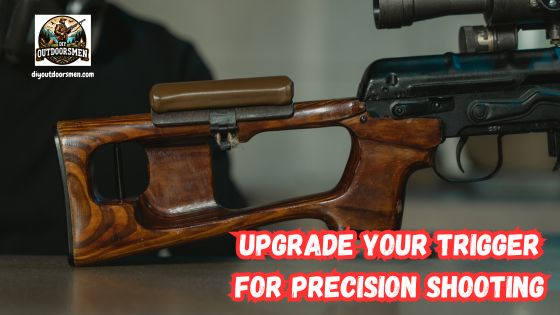Contents
- 1 Step 1: Evaluate Your Current Trigger System
- 2 Step 2: Research and Select Appropriate Trigger Components
- 3 Step 3: Choose a Precision Trigger Kit or Custom Components
- 4 Step 4: Install and Adjust Your New Trigger System
- 5 Step 5: Fine-Tune Trigger Pull and Reset
- 6 Step 6: Maintain Your Upgraded Trigger System
- 7 Step 7: Seek Professional Assistance and Continue Learning
- 8 Common Questions & Troubleshooting
- 9 Final Thoughts & Next Steps
Upgrading your rifle trigger can step up your shooting experience, especially when precision is your priority. A custom trigger system has the potential to improve accuracy, reduce trigger pull weight, and provide a more consistent feel.
QUICK LOOK: Steps for Upgrading Your Rifle Trigger
- Evaluate Your Current Trigger: Before making any modifications, it is important to understand how your current trigger works.
- Research and Select new Trigger: the next step is researching available trigger upgrade kits and individual components. It is wise to spend time reading reviews and comparing specifications to make sure your choice fits your shooting style and firearm model.
- Choose a Complete Kit or Custom Components: A complete kit might be simpler to install for those with limited mechanical experience, while seasoned shooters may appreciate the flexibility of selecting custom components that can be fine-tuned precisely to their preferences.
- Install and Adjust New Trigger: Installing a new trigger is a detailed task that requires precision, patience, and attention to detail. Following an installation guide specific to your trigger upgrade kit is very important to avoid any missteps.
- Fine Tune Trigger Pull: After installation, fine-tuning the trigger system is necessary to achieve optimal performance. Adjusting the trigger pull weight and reset can make a big difference in your shooting precision.
- Maintain New Trigger: After each shooting session, take the time to clean the trigger mechanism thoroughly and check for any signs of wear or damage. Consistent maintenance will keep the system performing at its best.
- Seek Professional Advice: If you ever feel uncertain about your modifications, it is a smart idea to consult a professional gunsmith. Even experienced shooters sometimes benefit from periodic consultations with professionals who have years of hands-on experience.
However, it is important to approach the upgrade with a clear plan and an understanding of your rifle’s current configuration. In many cases, taking the time to fully assess every component will pay off in reliability and performance on the range.
The following guide covers several detailed steps that I have found useful when upgrading a rifle trigger for precision shooting. I will discuss the process from assessing your current setup to fine-tuning and ongoing maintenance in a clear and structured way.
By following these steps, you can achieve a smoother, more responsive trigger that can lead to improved accuracy and a better overall shooting experience. This guide is designed to make it easy for both beginners and experienced shooters to follow along.
Step 1: Evaluate Your Current Trigger System
Before making any modifications, it is important to understand how your current trigger works. Evaluating your existing trigger mechanism helps you identify the areas that need improvement. I start by examining the trigger pull weight, reset, and overall feel.
A proper evaluation ensures that any changes made will address your specific needs rather than simply following a general upgrade trend. Taking detailed notes and, if possible, recording measurements will provide a useful reference later in the process.
Questions to Consider:
- What is the current trigger pull weight?
- Do you experience any inconsistencies when pulling the trigger?
- How does the trigger reset feel after each shot?
- Is the trigger designed for the type of shooting I perform?
Example Observations:
- If the trigger feels heavy or mushy, adjustments or replacement components may provide a crisper action.
- A short reset might lead to faster shooting. However, it requires careful tuning to avoid accidental discharges.
- Identifying any issues now can help guide the selection of upgrade parts and reduce future troubleshooting.
This initial evaluation lays the groundwork for a successful trigger upgrade and minimizes guesswork during the installation process. Spending extra time at this stage can save you considerable effort later on by ensuring that you know exactly what needs to be improved.
Step 2: Research and Select Appropriate Trigger Components
Once you have evaluated your current system, the next step is researching available trigger upgrade kits and individual components. Numerous manufacturers offer precision trigger kits that often include adjustable triggers, specific springs, and additional components to customize the feel and performance. It is wise to spend time reading reviews and comparing specifications to make sure your choice fits your shooting style and firearm model.
What to Look For:
- Compatibility with your firearm’s make and model.
- Adjustability in trigger pull weight and reset.
- Positive reviews from users who prioritize precision shooting.
- Quality of materials and construction for long-term durability.
Useful Research Tips:
- Consult manufacturer websites and trusted forums dedicated to precision shooting and firearms upgrades. It can be very helpful to check in with experienced users who have already made similar modifications.
- Compare the benefits and drawbacks of various upgrade kits and parts to determine what will meet your specific needs.
- Identify whether any specialized tools or professional assistance might be necessary during installation.
I have found that thorough research and reading firsthand user experiences can significantly affect the selection process. This measured approach reduces risk and ensures that the components chosen will truly give your rifle the boost in performance you are looking for. Adding extra time to compare options can make all the difference when it comes to the final result.
Step 3: Choose a Precision Trigger Kit or Custom Components
After gathering research, the next stage involves selecting the upgrade components best suited for your rifle. You have the option to purchase a complete trigger kit or source individual parts for a more tailored setup.
A complete kit might be simpler to install for those with limited mechanical experience, while seasoned shooters may appreciate the flexibility of selecting custom components that can be fine-tuned precisely to their preferences.
Considerations When Selecting Components:
- Decide whether you want a design that meets military specifications or one engineered specifically for competitive shooting.
- The ability to adjust and fine-tune the trigger settings through precision adjustments.
- Ease of installation, overall cost, and availability of support if needed.
- The reputation of the manufacturer and the quality of after-sale service can be very important when troubleshooting or making future modifications.
Choosing the right kit or components is all about ensuring that the upgrade aligns with your shooting style and safety expectations. It is a personal decision that takes into account both the mechanical aspects and the overall usability of your rifle during shooting sessions. Taking an extra moment to weigh your options now can lead to a setup that feels truly personalized and reliable over the long term.
Step 4: Install and Adjust Your New Trigger System
Installing a new trigger is a detailed task that requires precision, patience, and attention to detail. Even if you are experienced in firearm maintenance, following an installation guide specific to your trigger upgrade kit is very important to avoid any missteps. I recommend working in a tidy, well-lit area where all your parts and tools are neatly organized before you begin the installation process.
Steps to a Successful Installation:
- Carefully disassemble the rifle according to the manufacturer’s guidelines, ensuring that you follow all safety precautions and confirm that the firearm is completely unloaded.
- Remove the existing trigger components with care. It is a good idea to keep all screws and parts in a designated container so that nothing gets lost during reassembly.
- Follow the installation instructions for your new components. This process may involve replacing springs, trigger shoes, and adjusting screws to achieve your desired trigger feel.
- Take the time to double-check your work, ensuring that all parts are securely reassembled and that the new trigger system does not have any unintended movement or looseness.
This stage emphasizes patience. You are advised to test each change incrementally and to refer back to the manual frequently. If questions arise at any point, consulting a professional gunsmith is always a sensible option. A carefully executed installation is the foundation of a reliable and safe trigger upgrade.
Step 5: Fine-Tune Trigger Pull and Reset
After installation, fine-tuning the trigger system is necessary to achieve optimal performance. Adjusting the trigger pull weight and reset can make a big difference in your shooting precision. Many shooters find this stage particularly rewarding because it allows for a custom setup that fits your specific shooting style perfectly.
Fine-Tuning Tips:
- Use a trigger pull gauge to accurately measure the trigger pull weight, as precision is very important for consistency.
- Begin with the manufacturer’s recommended settings and then make gradual adjustments to pinpoint your ideal configuration.
- Test-fire the rifle in a controlled environment to ensure that adjustments produce the desired changes in performance.
- Keep a record of the adjustments made so that you can reproduce the ideal setting or make minor changes in the future.
This phase of the process often involves a degree of trial and error. The key is to make small modifications and test extensively. Over time, this systematic approach results in a setup that is not only consistent but also perfectly attuned to your style of shooting. It is a stage where persistence and careful measurement clearly pay off.
Step 6: Maintain Your Upgraded Trigger System
The long-term performance of your upgraded trigger greatly depends on how well it is maintained. Routine cleaning and regular inspections are very important. After each shooting session, take the time to clean the trigger mechanism thoroughly and check for any signs of wear or damage. Consistent maintenance will keep the system performing at its best.
Maintenance Tips:
- Regularly clean the trigger assembly using appropriate cleaning agents to remove debris and residue.
- Inspect all components for signs of wear or damage and make replacements as needed.
- Keep a maintenance log that details any adjustments or issues over time so you can track performance improvements or emerging issues.
- If you operate your rifle in harsh weather or frequently challenging environments, consider extra cleaning sessions to prevent corrosion or buildup of debris.
Proper maintenance is just as important as the installation itself. Being diligent in cleaning and inspection routines ensures that your upgraded trigger system continues to perform reliably and safely. This routine not only extends the life of your components but also helps maintain that smooth, custom feel you worked so hard to achieve.
Step 7: Seek Professional Assistance and Continue Learning
If you ever feel uncertain about your modifications, it is a smart idea to consult a professional gunsmith. There is no harm in seeking expert advice, especially when dealing with a trigger system that directly affects both safety and performance. Even experienced shooters sometimes benefit from periodic consultations with professionals who have years of hands-on experience.
Ways to Step Up Your Knowledge:
- Attend shooting workshops or seminars that focus on trigger control and precision shooting techniques.
- Join online forums or local clubs where enthusiasts actively share their experiences with different trigger setups and modifications.
- Stay updated with the latest trends in trigger technology and upgrade components by checking trusted sources regularly.
- Review detailed technical manuals and guides that provide in-depth explanations of trigger dynamics and maintenance practices.
This step is all about continuing your education and remaining open to opportunities for improvement. Regular professional assessments and self-education contribute to a long-term, reliable performance that keeps your shooting skills sharp. Remember, every bit of extra knowledge can help you make better decisions the next time you decide to modify your trigger system.
Common Questions & Troubleshooting

What if the trigger feels too light or too heavy?
If the trigger pull weight does not feel right, adjust the mechanism using small increments until you find the balance that works for you. A trigger pull gauge is key for monitoring these changes, and following the kit’s instructions carefully is essential. In some cases, the solution may involve altering spring tension or even replacing certain components entirely.
How do I know if the trigger reset is correct?
The trigger reset is working well when the trigger snaps back consistently with each pull. A strong indicator that everything is set up correctly is when shots are fired with very little deviation in force or timing. If you notice any lag or inconsistency between pulls, further fine-tuning may be necessary.
What should I do if I encounter problems after the upgrade?
Review each installation step to ensure every part was reassembled correctly and securely.
Consult troubleshooting guides specific to your chosen trigger kit or component brand.
If uncertainties persist, a visit to a professional gunsmith can help sort out any issues safely and efficiently.
Is it necessary to continuously adjust the trigger over time?
As with any finely tuned mechanical system, periodic adjustments may be needed to maintain peak performance. Regular cleaning, careful storage, and occasional re-checks will ensure that your upgraded trigger continues to work as intended over long periods of use. This proactive approach helps in minimizing unexpected issues during critical moments.
Final Thoughts & Next Steps
A well-upgraded rifle trigger can make a significant difference when it comes to precision shooting. With a customized trigger, you can achieve a smoother, more predictable response that boosts overall shooting accuracy, and confidence.
Every step—from evaluating your existing system to rigorous fine-tuning—adds value to your setup. It is not just about making modifications; it is about building a reliable system that works in harmony with your shooting style. Taking the time to get everything right today could influence your performance on the range for years to come.
Your Trigger Upgrade Action Plan:
- Evaluate your current trigger system and note specific issues that need to be addressed.
- Research and select upgrade components that match both your firearm model and shooting style.
- Decide whether a complete trigger kit or a selection of custom components will best suit your needs.
- Carefully install the new parts, ensuring you follow all manufacturer guidelines and safety protocols.
- Fine-tune the trigger pull weight and reset settings incrementally, testing thoroughly on the range.
- Commit to regular maintenance to ensure lasting performance from your upgraded system.
- When in doubt, ask for help from professional gunsmiths or fellow shooting enthusiasts.
This plan offers a structured approach to upgrading your rifle trigger. Taking the time to follow each step and investing in extra research or professional advice can lead to noticeable improvements in your shooting experience.
What is the one modification you are considering for your trigger? The changes you make today might just shape your performance and confidence for years down the line.
By following this all-in-one guide, you are setting yourself up for success in precision shooting. The knowledge and steps provided here are designed to work together in a smooth, predictable fashion, so each improvement builds on the previous one.
Whether you are a novice or a seasoned shooter, taking the time to review, customize, and regularly maintain your trigger will pay off in the long run. Enjoy the process of making your rifle truly yours and watch as every shot becomes a testament to your careful planning and dedication.
Check Out Our Latest Articles:
- Understanding Deer Behavior To Improve Your Hunt

- Complete Guide On Tracking Game Animals

- DIY 4-Step Guide To Field Dressing And Quartering A Deer

- Night Vision Binoculars For Nocturnal Hunting

- The Science Behind Camouflage Patterns For Deer Hunting

- Binocular Accessories For Hunters

As always, stay safe, enjoy the journey and please try to leave it cleaner than you found it. If you have any comments, questions, ideas, or suggestions please leave them in the comment section below and I’ll get back to you ASAP. You can follow us on YouTube: Man Art Creations for videos of our DIY Adventures.
P.S. – Thanks so much for checking out our blog we really appreciate it. Just so you know, we may receive a commission if you click on some of the links that appear on our site. This helps us keep our content free and up-to-date for everyone. We appreciate your support!


